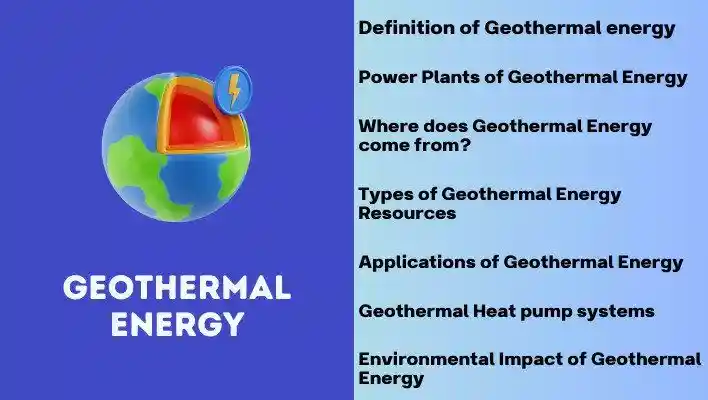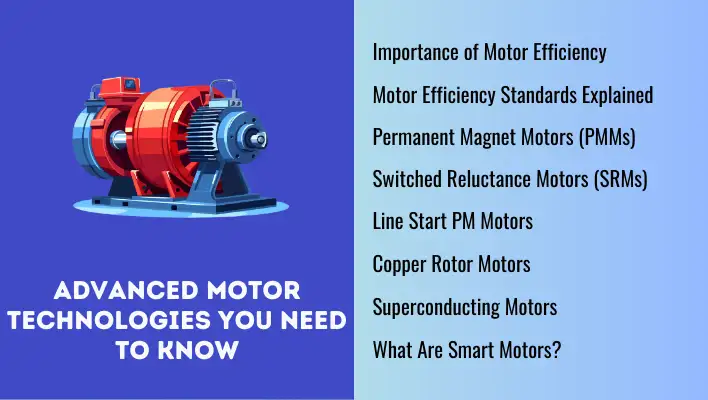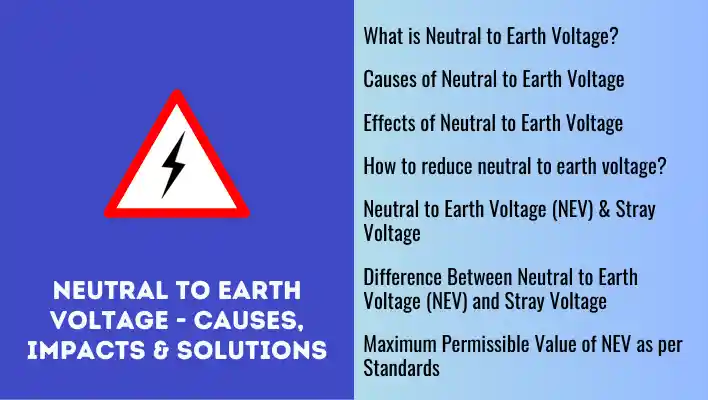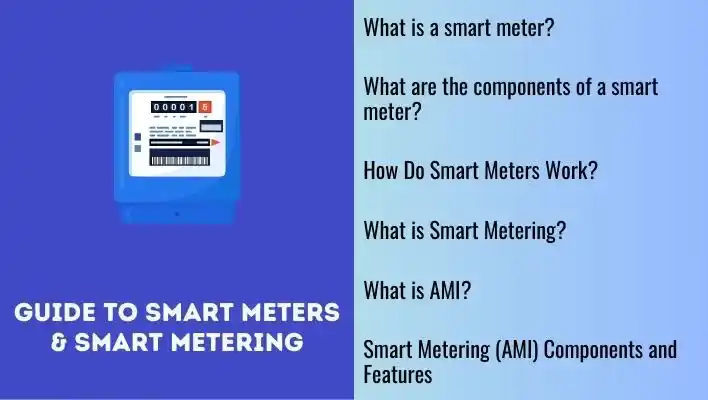Geothermal energy is a clean and renewable energy source that taps into the Earth’s core heat to generate electricity. It stands out for its eco-friendly nature, as it doesn’t emit harmful pollutants like fossil fuels do.
As the global demand for clean energy rises and the push to reduce reliance on traditional fuels grows, geothermal energy is gaining popularity as a reliable and sustainable power option. This article delves into the fundamentals of geothermal energy, its extraction process, and its potential in meeting our energy requirements.
Also Read: Explained | Top 7 Solar Energy technologies
What is the definition of Geothermal energy?
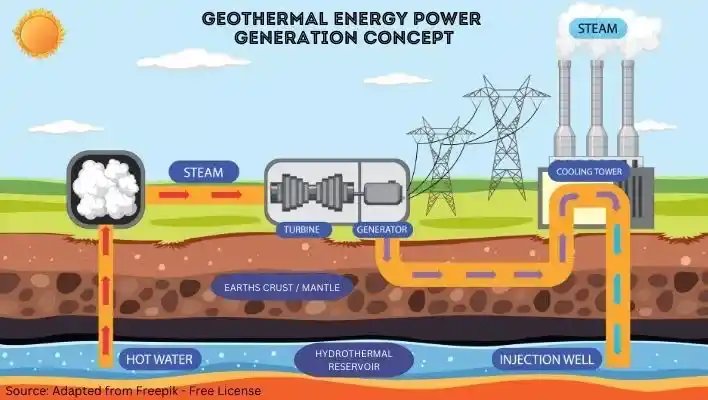
Geothermal is a combination of “Geo” (earth) and “Thermal” (heat), referring to the heat energy naturally present within the Earth. This energy originates primarily from the decay of radioactive isotopes such as uranium, thorium, and potassium, along with the residual heat from the Earth’s initial formation billions of years ago.
Geothermal technology facilitates the extraction of subsurface heat, enabling its direct utilization for heating and cooling or its conversion into electricity. It is important to note that not all of the Earth’s heat can be accessed, and the recoverable portion through boreholes is specifically termed as Geothermal Energy.
To generate electricity, it is essential to have medium or high-temperature resources, usually located in tectonically active regions. In these areas, hot water and/or steam can either naturally emerge at the Earth’s surface or be accessible at shallow depths.
The key characteristic of geothermal energy is that it provides stable and dispatchable electricity. “Dispatchable” refers to the ability to control and adjust the output of electricity according to demand. This feature allows geothermal power plants to respond promptly to fluctuations in energy needs, enhancing grid stability.
The stable and dispatchable characteristic of geothermal energy complements intermittent power sources such as solar and wind, providing a reliable foundation for the electricity system and addressing the challenges associated with variability in renewable energy production.
Good to Know: Earth radiates heat equivalent to burning 30 billion tonnes of coal. Relying solely on geothermal energy for humanity's needs would cool the Earth by 1 °C every 40 million years.
Also Read: Wind Energy 101: Explore the Basics of a Sustainable Future
What is the ultimate source of Geothermal Energy?
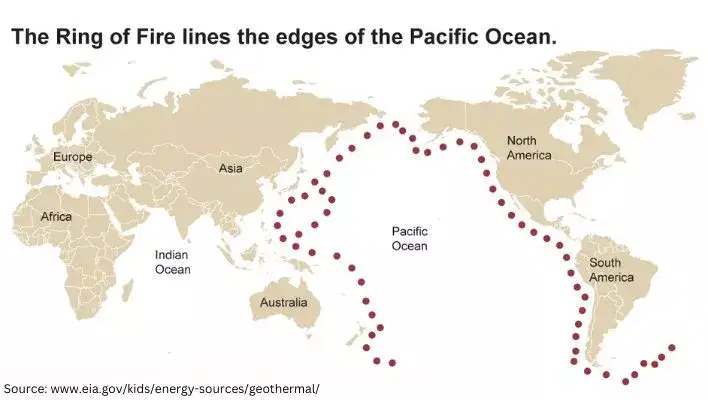
The ultimate source of geothermal energy is hydrothermal reservoirs, which are concealed deep beneath the Earth’s surface and are generally not noticeable above ground. This type of energy finds its way to the earth’s surface in three ways,:
- Volcanoes and Fumaroles (Openings in the Earth’s surface emitting volcanic gases)
- Hot Springs
- Geysers
The most active hydrothermal resources are typically found along major tectonic plate boundaries, where the majority of volcanoes are concentrated. For example the Ring of Fire, encircling the Pacific Ocean.
Good To Know: Fumaroles are vents in the Earth's crust that expel super-heated steam and gases, reaching temperatures ranging from 200 to 800 °C. Typically formed by gases released from molten magma.
Where does Geothermal Energy come from?
Scientists have identified that the Earth’s inner core registers a temperature of around 6000°C, same as the sun’s surface.
In the mantle, temperatures range from approximately 200°C at the upper boundary adjacent to the Earth’s crust to about 4000°C at the mantle-core boundary.
This high-temperature heat from the Earth’s core continuously travels towards the Earth’s surface, thereby transmitting the heat to the adjoining rocks called the mantle.
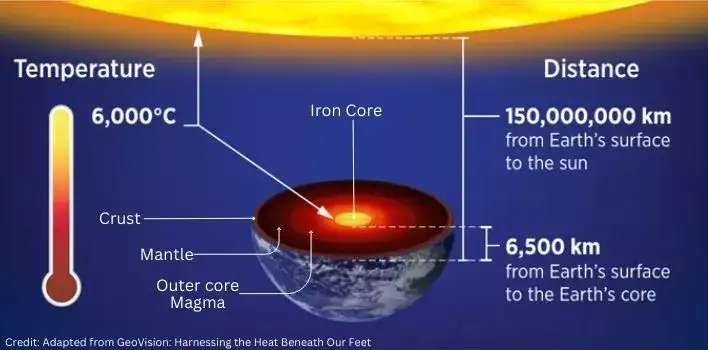
Due to constant heating, the temperatures and pressures rise enough to melt the mantle rock to form magma. The magma, being less dense than the surrounding rock, rises and slowly moves towards the Earth’s crust, carrying the heat from the core.
At times, the magma comes out on the surface in the form of molten rock (lava) or stays beneath the crust, heating nearby rock and water that has penetrated deep into the Earth.
Some of this hot geothermal water passes through the faults and cracks of the Earth, reaching the surface as hot springs or geysers, while the majority remains trapped in cracks and porous rock, forming a natural collection known as a Hydrothermal (Geothermal) reservoir.
Volcanoes, hot springs, geysers, and fumaroles are some examples of geothermal energy that reach the Earth’s surface. However, most geothermal energy is not visible as it is deep underground.
Also Read: Renewable Energy | A comprehensive explanation
Types of Geothermal Energy Resources
Geothermal resources are classified in various ways on the basis of heat source, heat transfer, reservoir temperature, physical state, utilization and geological settings.
Based on the geological settings the energy can be generated from four different types of resources,
- Hydrothermal
- Geo-pressured
- Hot dry rock
- Magma

Hydrothermal
Hydrothermal resources form when underground water comes into contact with high-temperature rocks, sealed by a watertight solid layer. The underground water reservoir gets heated by surrounding rocks, with magma supplying heat through upward conduction beneath the reservoir.
In these conditions, the underground water reservoir’s temperature rises. The super-heated water, which is surrounded by high-temperature impervious rocks, behaves like a fuel-burning boiler, reaching temperatures up to 350°C due to continuous heating.
Under intense pressure and high temperatures, hot water and steam escape through rock fractures, creating features like hot springs or geysers. However, the majority of the heated water and steam remains below the surface.
This underground pool of hot water is termed a Hydrothermal Reservoir, accessed by digging wells or boreholes for harnessing hydrothermal energy.
Hydrothermal reservoirs contain vapor or dry steam fields, liquid systems, and hot-water fields. They contain super-heated water, steam, or both in fractures or porous rock, confined by a layer of airtight rock formations above.
Hydrothermal fluids can be directly employed for heating buildings, greenhouses, and swimming pools, or utilized to produce steam for electrical power generation.
Geo-pressured resources
Deep within the Earth, at depths ranging from 3 KM to 6 KM, there exist relatively high-temperature brines, which are essentially hot salty water. These brines, subjected to immense pressure, are naturally sealed by a porous layer of rock.
Unlike hydrothermal fluids, brines are found even deeper underground, resulting in exceedingly high pressure, reaching up to 1350 ATM in the Earth’s deepest layers. Such high-pressure reservoirs are termed Geo-pressured resources.
Brines possess a noteworthy quality – they contain significant concentrations of methane gas. Through gravity separation methods, methane gas can be extracted and traded, providing an additional revenue stream for the power plant.
Three types of energy can be extracted from Geo-pressured resources:
- Thermal energy from heated fluids.
- Mechanical energy from high pressures.
- Chemical energy from methane gas.
Hot Dry Rock
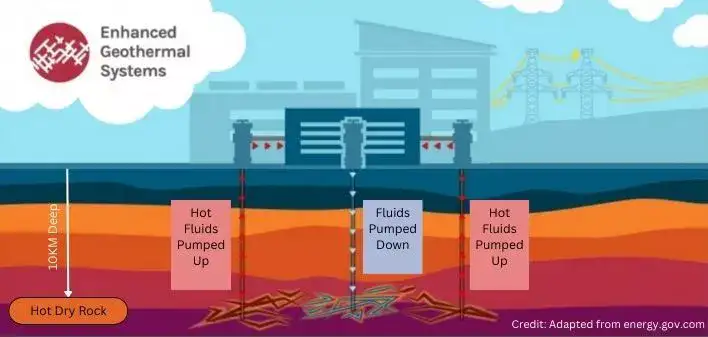
Hot dry rock resources involve heat trapped in rocks located nearly 10 KM deep beneath the surface. Extracting heat from these rocks poses a challenge as there is no natural hot water or steam to transport the substantial heat stored in the hot rock to a production well for extraction. Additionally, the reservoir rocks have low porosity and minimal permeability.
The process to extract heat from Hot Dry Rock (HDR) resources involves fracturing the rock and establishing a fluid circulation system, known as an Enhanced Geothermal System (EGS).
High pressure is utilized to crack the rocks and create wells. Then cold water is pumped through one well, and as it passes through HDR cracks, it becomes a hydrothermal fluid through conduction.
This hydrothermal fluid is then extracted from another well at a distance within a closed-loop system for power generation.
Good To Know: Cooling 1 km3 of heated rock by 100 °C yields sufficient energy to sustain a 30 MW plant for a period of 30 years.
Magma
Magma, partially melted rock situated deep within the Earth’s interior at depths ranging from 3 to 10 km, represents a substantial global geothermal resource. However, accessing and extracting energy from magma proves challenging due to its significant depth and high temperatures, ranging between 700°C and 1200°C. Currently, the drilling technology required for harnessing this resource is still in the developmental stage.
Specialized drilling technology is essential for dealing with magma resources. The drills utilized must be compatible with molten rock, gases, and the mechanisms of heat transport within molten magma.
Power Plants of Geothermal Energy
The technology used for generating power is determined by the geothermal field’s heat content. High to medium heat content is necessary for power generation. Based on heat content criteria there are currently four options for technology in geothermal power generation.
- Dry steam plants
- Flash steam plants
- Binary power plants
- Combined-cycle or Hybrid plants
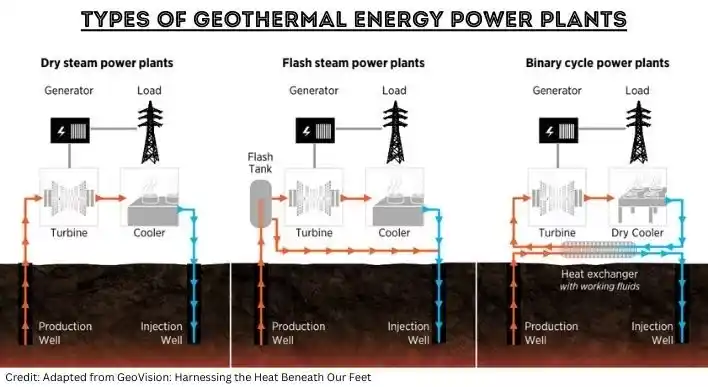
Dry steam plants
Dry steam systems were the initial type of geothermal power generation plants constructed. In this arrangement, condensing steam turbines handle the low-pressure, high-volume fluid derived from the geothermal steam field.
The process begins with the direct extraction of steam from an underground geothermal source through drilling. Thereafter, the steam undergoes processing via a turbine and generator unit. The resulting condensate, or water produced during steam processing, is either pumped back into the geothermal reservoir or evaporated in wet cooling towers.
To operate efficiently, dry steam plants necessitate steam at a temperature of 150 degrees Celsius or higher. Additionally, the steam entering the turbine must be entirely dry to prevent scaling or erosion of turbine and piping components. Plant sizes typically range from 8 MW to 140 MW.
This power generation method does not involve combustion, resulting in lower emissions compared to fossil fuel power plants. Emissions consist of a minor amount of sulfur dioxide, hydrogen sulfide, carbon dioxide, and excess steam.
Flash steam plants
The predominant type of geothermal power plants currently employed is the Flash Steam power plant. These plants are identical to Dry Steam Plants and utilize a process called flashing to extract steam.
In this method, water with temperatures exceeding 360°F (182°C) is brought to the surface under high pressure to the generation equipment. Within the generation equipment, the pressure is reduced, causing a portion of the hot water to convert or “flash” into steam.
This resultant steam is then employed to drive the turbine/generator units to generate electricity. The remaining unflashed water and steam condensate are subsequently pumped back into the reservoir.
The size of flash power plants varies based on whether they are categorized as single flash (0.2-80 MW), double flash (2-110 MW), or triple-flash (60-150 MW) plants.
Binary Power Plants
Binary cycle power plants differ from dry steam or flash steam power plants. In this type of power plant, heat exchangers are utilized to facilitate an exchange of heat between the water from the geothermal reservoir and another “working fluid.”
This working fluid undergoes vaporization and is employed to rotate the turbine/generator units. Typically, the working fluid is Isobutane or Isopentane, both have a lower boiling point than water.
Geothermal fluid and the working fluid operate in separate circulating systems or “closed loops,” ensuring they never come into direct contact. The steam generated from the working fluid is condensed, and the hydrothermal fluid is returned to the Earth. This cyclic process is swiftly repeated to allow the Earth to reheat the fluid.
Binary plants offer an advantage as they are suitable for resources with lower temperatures ranging between 100°C and 170°C. Although operation at temperatures lower than 100°C is possible, it results in decreased efficiency in electricity output.
The size of binary plants varies, ranging from less than 1 MW to 50 MW.
Combined-cycle or Hybrid plants
Combined-cycle geothermal power plants employ both a standard Rankine cycle and a binary cycle to effectively generate electricity from waste heat. These plants typically vary in size from a few to 10 MW.
Hybrid geothermal power plants follow the same fundamental principles as normal geothermal power plants but integrate additional heat sources. These additional sources are taken from a concentrating solar power plant to enhance the temperature and power output of the geothermal brine.
Also Read: Explore what Energy is? Types, Sources and Importance of Energy Conservation
Applications of Direct use of Geothermal Energy
Direct use of geothermal energy involves utilizing hot water from geothermal resources to supply heat for various purposes, including industrial activities, crop drying, and building space heating.
The hot fluid extracted from the geothermal resource is either directed through heat exchangers or supplied directly to industrial, commercial, or residential buildings to fulfill their heating and hot-water requirements.
Geothermal direct use, in combination with geothermal heat pumps, contributes to saving 100 million barrels of oil annually. This approach is implemented in over 82 countries worldwide.
Main applications of direct use are as follows,
- Space heating
- Air conditioning
- Industrial processes
- Drying
- Greenhouses
- Aquaculture
- Hot water
- Resorts and pull
- Melting snow
Geothermal Heat pump systems (GHPs)
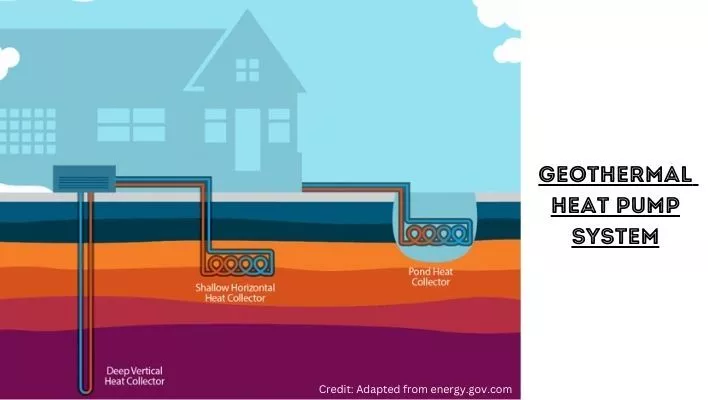
Ground-source or Geothermal Heat Pumps (GHPs) leverage the thermal storage characteristics of the shallow earth to deliver efficient heating and cooling.
While examples like volcanoes, hot springs, geysers, and fumaroles showcase geothermal energy reaching the Earth’s surface, the majority of this energy is located deep underground and remains largely inaccessible.
These heat pumps utilize the Earth’s constant temperatures, typically ranging between 10 and 15 degrees Celsius in the upper 3 to 4 meters of the Earth’s surface. This means that soil temperatures are cooler than the air in summer and warmer than the air in winter.
GHPs capitalize on the soil’s thermal properties, transferring heat from the ground or water into buildings during winter and reversing the process in the summer. As a result, they help maintain a cooler environment during summer and a warmer one during winter for homes, schools, offices, and commercial buildings.
Environmental Impact of Geothermal Energy
- Land Disruption: The construction and drilling processes involved in geothermal projects can disturb local ecosystems and habitats. This disruption may affect flora and fauna in the vicinity, requiring careful planning and mitigation strategies to minimize ecological impacts.
- Induced Seismic Activity: Enhanced geothermal systems (EGS) involve creating fractures in the Earth’s crust to enhance heat extraction. This process can induce small seismic events. While these are typically of low magnitude and pose minimal risk, proper site selection and monitoring are crucial to ensure safety and minimize any potential impact on nearby communities.
- Resource Depletion: Continuous extraction of geothermal fluids without proper management can lead to the depletion of the geothermal reservoir over time. Sustainable reservoir management practices, such as reinjection of fluids, are essential to maintain long-term resource viability.
- Chemical Emissions: Geothermal power plants release trace amounts of gases, including hydrogen sulfide and radon, during the extraction and generation process. While these emissions are generally at lower levels than those associated with fossil fuel combustion, monitoring and adherence to emission standards are important to mitigate any potential health or environmental risks.
- Brine Disposal: Geothermal fluid, which often contains dissolved minerals and salts (brine), is extracted during the power generation process. Proper disposal of this brine is crucial to prevent contamination of soil and water. Responsible management practices, such as reinjection into the reservoir or controlled discharge, aim to minimize environmental impact.
Good To Know: A geothermal power plant that works with an open cycle lets out about 100 grams of CO2 for every 1 kWh of electricity it produces. This is only one-tenth of the CO2 released when making 1 kWh of electricity from coal. So, geothermal is much cleaner!
Advantages of Geothermal Energy
- Reliable and Economical: Geothermal energy serves as a dependable and cost-effective energy source.
- Continuous Availability: The energy is accessible 24 hours a day, ensuring a constant power supply.
- Weather Independence: Geothermal energy availability is not reliant on weather conditions, providing consistency.
- Natural Storage: It features a natural storage capability, eliminating the need for additional storage facilities.
- Compact Power Plants: Geothermal power plants require minimal land area for operation.
- Modular Approach: The technology allows for a viable modular approach, presenting numerous opportunities for the development of quick and cost-effective geothermal projects.
Disadvantages to Geothermal Energy
- Limited Site Availability: Geothermal plants can only be constructed at specific locations, limiting their widespread implementation.
- Low-Grade Heat: Often, the energy obtained is of low-grade heat, impacting its efficiency for certain applications.
- Ground Surface Instability: Continuous extraction of heated groundwater may result in sinking or caving in of the ground surface.
- Environmental Impacts: Geothermal fluid carries dissolved gases and solutes, contributing to air and land pollution.
- Noise Pollution: Drilling holes and digging wells for geothermal energy generation can lead to noise pollution.
- Limited Distribution Range: Thermal energy available is challenging to distribute over long distances, posing logistical challenges.
- Reduced Plant Lifespan: Corrosive and abrasive characteristics of geothermal fluid can decrease the lifespan of the plant.
Summary
Geothermal energy is a renewable source that taps into the Earth’s core heat to produce electricity and provide heating for buildings. It can power geothermal plants for electricity generation.
Four types of resources contribute to geothermal energy: Hydrothermal, Geo-pressurized, Hot Dry Rock, and Magma, depending on geological settings.
There are four technology options for geothermal power generation: Dry steam plants, Flash steam plants, Binary power plants, and Combined-cycle or hybrid plants.
The Earth’s surface thermal storage properties can be efficiently harnessed for building cooling and heating using GHSs technology.
Geothermal Direct use, combined with geothermal heat pumps, annually saves 100 million barrels of oil.
FAQs
is geothermal energy renewable or nonrenewable?
Geothermal energy is considered renewable. It is derived from the Earth’s internal heat, primarily from radioactive decay of minerals and residual heat from the planet’s formation. As these heat sources are naturally replenished over time, geothermal energy is considered a sustainable and renewable resource.
how can one tap geothermal energy?
Geothermal energy is harnessed through power plants (steam and binary cycle), heat pumps for buildings, direct use applications (heating, industry), enhanced geothermal systems, Geo-pressurized and hot dry rock resources. These methods tap into the Earth’s internal heat, providing sustainable and renewable energy solutions.
where geothermal energy is found?
Geothermal energy is found at tectonic plate boundaries, the Ring of Fire, the Mid-Atlantic Ridge, hot-spots, volcanic regions, and certain continental areas like Iceland and the Philippines. These locations provide accessible Earth’s heat for sustainable energy use.
Can geothermal energy be used for heating and cooling in homes?
Yes, geothermal heat pumps are commonly used for residential heating and cooling. These systems use the stable temperature of the ground to efficiently heat or cool buildings.
What are the challenges associated with geothermal energy?
Challenges include the location-specific nature of geothermal resources, the upfront costs of drilling and plant construction, and the potential for resource depletion if not managed sustainably.
Can geothermal energy be used for more than just electricity generation?
Yes, besides electricity generation, geothermal energy is used for direct heating applications in industries, greenhouses, and district heating systems. It is also employed for spa and wellness purposes in geothermal hot springs.
How long can a geothermal power plant operate?
Geothermal power plants can have a long operational life, typically exceeding 20 to 30 years. The lifespan may vary depending on factors such as the type of plant and maintenance practices.
Does Geothermal Energy depend on weather conditions?
Geothermal energy is relatively constant compared to some other renewable sources like solar and wind. It is not dependent on weather conditions and can provide a consistent and reliable source of power.
References
- https://www.eia.gov/energyexplained/geothermal/
- https://www.energy.gov/eere/geothermal/geothermal-basics
- https://www.eia.gov/kids/energy-sources/geothermal/
- https://www.nrel.gov/research/re-geo-elec-production.html
- https://www.irena.org/Energy-Transition/Technology/Geothermal-energy
- https://www.energy.gov/eere/geothermal/enhanced-geothermal-systems
- https://www.energy.gov/eere/geothermal/geovision

